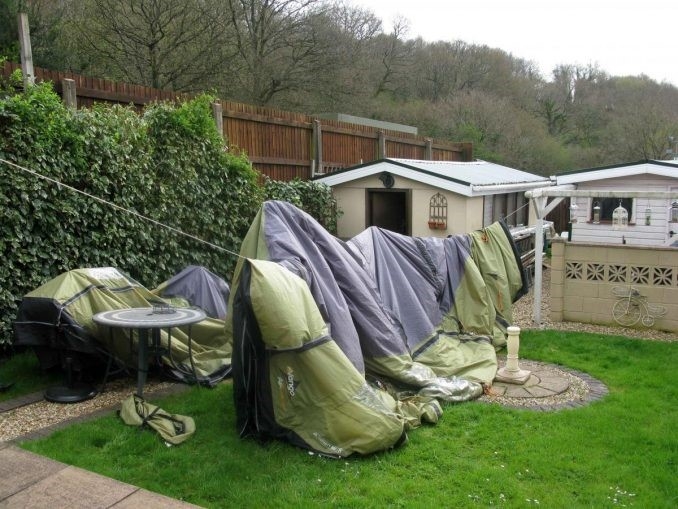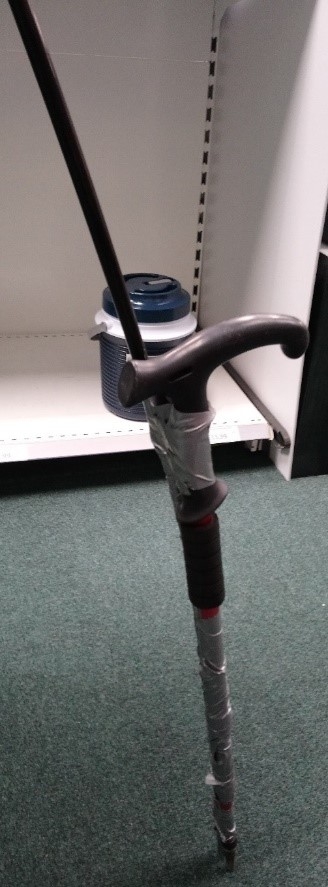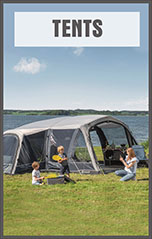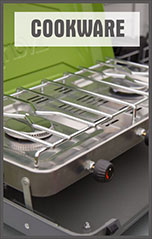Expert Advice on Looking after your tent or awning
To get the longest life out of your tent it is necessary to do some simple maintenance to not only get the most out of your tent, but also to get the longest lifespan out of your tent. A tent in full good working condition will make your holiday much more enjoyable.
Environmental contaminants can cause damage to your tent, particularly if camping in an area with overhanging trees or shrubbery. Falling pollen and resin can stick to the canvas and cause deterioration along with the inevitable guano that is associated with camping in woodland areas.
Cleaning your tents material with fresh water is the best way to remove these contaminants without stripping any waterproof coating. It is worth noting that no soaps or detergents should be used on the fabric of the tent as this can damage the coating.

After a season’s camping it is recommended to re- proof your tent using a suitable waterproofing spray such as Fabsil. 1Ltr of Fabsil will cover around 7.5 square meters of light weight tent material so a little goes a long way. Just wash the tent over first with clean water and allow it to dry before the tent is re-proofed.
For convenience Fabsil is also available in spray cans meaning less mess and instant operation.


To reduce condensation inside the tent it is recommended that washing is not dried inside tents or awnings and washing up is also not done inside as this can caused the formation of mould on the inside of the tent.
There are light and compact washing lines available to take with you when camping so this will make it possible to dry freshly washed and wet clothes without drying them in your tent or awning.
Mould is both unpleasant and can be a hazard to health, because of this it is worth noting that the material should be dry when it is packed away. If there is no option but to pack away the tent wet, then it should be pitched again as soon as possible at home in the garden or at a local campsite to properly dry the material before it is packed away for a long period of time. This can also be used as an opportunity to inspect for any damage that will need to be fixed before next time.
Tents and awnings can also be laid over your garden washing line to aid the drying process as the wind will blow dry the tent, it also helps to try and avoid drying the tent laying on damp grass as this will significantly reduce the drying time.

Soap and detergents can cause the material to lose some of its water repellant coating, because of this freshly washed clothes and towels should not be dried laying over any part of the tent or inside the tent.
It is worth noting that Polycotton tents do not require waterproofing due to the nature of the material acting as a natural waterproof material, however they usually require weathering before the first use to make them waterproof by activating the material.
Cooking in your tent is also best avoided, not only does burning gas cause condensation, it also releases Carbon Monoxide into the air which is odorless and poisonous. There is also the fire risk entailed with open flames inside tents as they are flammable.

Repairs should be made to your tent as soon as you return, and any field repairs should be rectified ready for when you go away next time.
It is worth noting that no tent manufacturer will cover damaged poles under warranty, so it’s better to repair your poles as soon as possible to prevent any further damage including damage to the pole sleeves.
Whilst there are all sorts of wonderful pole temporary fixes that we have seen such as the below photo, it is always better where possible to replace the pole sections with a good quality, correct length replacement poles.

We stock a range of poles which are great for carrying as spares when you go away, although it is worthwhile checking if the sections are the same length as the ones that your tent uses and if not the universal sections can be shortened to the correct length so you can replace them quickly and easily at the campsite.
Any damage caused to the flysheet can also be repaired ready for your next trip.
If the damage is small then kits such as the Kampa tent and awning repair kit is ideal to repair your tent, they can also be used to repair the inflatable air tubes used in most inflatable awnings and tents.

Zips are an integral part to almost any tent or awning, and these are an easy component to damage.
By always making sure the inner doors are zipped shut before the tent is pitched, this prevents undue tension being exerted onto the zips once the tent is fully set up allowing the zips to work correctly.
It is also worth noting that the tent front door should be left open so that air isn’t trapped in the tent when it is rolled up ready to pitch it again next time, this makes it an easier job pitching the tent and it makes it much easier to pack away too.
If you have any further queries, please feel free to contact the sales team












